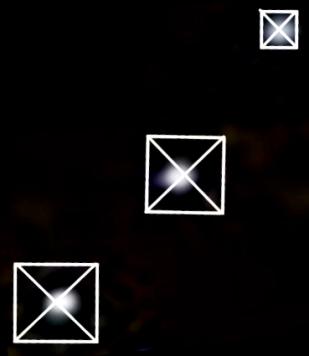http://en.wikipedia.org/wiki/Orion_correlation_theory wrote:
<<The Orion correlation theory (or Giza–Orion correlation theory) is a hypothesis in pyramidology. Its central claim is that there is a correlation between the location of the 3 largest pyramids of the Giza pyramid complex and the three middle stars of the constellation Orion, and that this correlation was intended as such by the builders of the pyramids. The stars of Orion were associated with Osiris, the sun-god of rebirth and afterlife, by the ancient Egyptians. Depending on the version of the theory, additional pyramids can be included to complete the picture of the Orion constellation, and the Nile river can be included to match with the Milky Way galaxy.
The Orion correlation theory was first put forward by Robert Bauval in 1983. One night, while working in Saudi Arabia, he took his family and a friend's family up into the sand dunes of the Arabian desert for a camping expedition. His friend pointed out Orion, and mentioned that Mintaka, the smaller more westerly of the stars making up Orion's belt was offset slightly from the others. Bauval then made a connection between the layout of the three main stars in Orion's belt and the layout of the three main pyramids in the Giza necropolis. He published this idea in 1989 in the journal Discussions in Egyptology, volume 13. The idea has been further expounded by Bauval in collaboration with Adrian Gilbert (The Orion Mystery, 1994) and Graham Hancock (Keeper of Genesis, 1996), as well as in their separate publications. The basis of this theory concerns the proposition that the relative positions of three main Ancient Egyptian pyramids on the Giza plateau are (by design) correlated with the relative positions of the three stars in the constellation of Orion which make up Orion's Belt— as these stars appeared 10,000 BC.
Their initial claims regarding the alignment of the Giza pyramids with Orion ("…the three pyramids were a terrestrial map of the three stars of Orion's belt"— Hancock's Fingerprints of the Gods, 1995, p. 375) are later joined with speculation about the age of the Great Sphinx (Hancock and Bauval, Keeper of Genesis, published 1996, and in 1997 in the U.S. as The Message of the Sphinx). According to these works, the Great Sphinx was constructed c. 10,500 BC (Upper Paleolithic), and its lion-shape is maintained to be a definitive reference to the constellation of Leo. Furthermore, the orientation and dispositions of the Sphinx, the Giza pyramids and the Nile River relative to one another on the ground is put forward as an accurate reflection or "map" of the constellations of Leo, Orion (specifically, Orion's Belt) and the Milky Way respectively. As Hancock puts it in 1998's The Mars Mystery (co-authored with Bauval):
...we have demonstrated with a substantial body of evidence that the pattern of stars that is "frozen" on the ground at Giza in the form of the three pyramids and the Sphinx represents the disposition of the constellations of Orion and Leo as they looked at the moment of sunrise on the spring equinox during the astronomical "Age of Leo" (i.e., the epoch in which the Sun was "housed" by Leo on the spring equinox.) Like all precessional ages this was a 2,160-year period. It is generally calculated to have fallen between the Gregorian calendar dates of 10,970 and 8810 BC. (op. cit., p.189)

The allusions to dates c. 12,500 years ago are significant to Hancock since this is the era he seeks to assign to the advanced progenitor civilization, now vanished, but which he contends through most of his works had existed and whose advanced technology influenced and shaped the development of the world's (known) civilizations of antiquity. Egyptology and archaeological science maintain that available evidence indicates that the Giza pyramids were constructed during the Fourth dynasty period (3rd millennium BC), while the exact date of the Great Sphinx is still unclear. Hancock does not dispute the dating evidence for the pyramids, but instead argues that they must have been planned with the knowledge of how the stars had appeared some eight thousand years before they were actually built —since the Orion correlation theory claims they are oriented that way— which it is implied provides further evidence for the influence of a technology and knowledge which would not have been available to the pyramids' builders.
The claims made by Hancock, Bauval, and others (such as Adrian Gilbert and Anthony West) concerning the significance of these proposed correlations have been examined by several scientists, who have published detailed criticism and rebuttal of these ideas.
Among these critiques are several from two astronomers, Ed Krupp of Griffith Observatory in Los Angeles and Anthony Fairall, astronomy professor at the University of Cape Town, South Africa. Using planetarium equipment, Krupp and Fairall independently investigated the angle between the alignment of Orion's Belt and north during the era cited by Hancock, Bauval et al. (which differs from the angle seen today or in the 3rd millennium BC, because of the precession of the equinoxes), and found that the angle was somewhat different from the "perfect match" claimed by Bauval and Hancock in the Orion Constellation Theory– 47-50 degrees per the planetarium measurements, compared to the 38 degree angle formed by the pyramids.
Krupp also pointed out that the slightly-bent line formed by the three pyramids was deviated towards the north, whereas the slight "kink" in the line of Orion's Belt was deformed to the south, and to match them up one or the other of them had to be turned upside-down. Indeed, this is what was done in the original book by Bauval and Gilbert (The Orion Mystery), which compared images of the pyramids and Orion without revealing the pyramids' map had been inverted. Krupp and Fairall find other problems with the claims, including noting that if the Sphinx is meant to represent the constellation of Leo, then it should be on the opposite side of the Nile (the "Milky Way") from the pyramids ("Orion"), that the vernal equinox c. 10,500 BC was in Virgo and not Leo, and that in any case the constellations of the Zodiac originate from Mesopotamia and are completely unknown in Egypt until the much later Graeco-Roman era. Ed Krupp repeated this "upside down" claim in the BBC documentary Atlantis Reborn (1999).
According to Bauval and Hancock, some astronomers (including Dr. Archie Roy, Dr. Percy Seymour, Dr. Mary Bruck, Dr. Giulio Magli), however, have rejected Krupp's argument. The correlation, they claim, is a visual one when standing north of the Giza pyramids and looking south. Archie Roy, professor Emeritus of Astronomy at Glasgow University, and Percy Seymour, astronomer and astrophysicist at Plymouth University U.K., have both publicly rejected several of Krupp's arguments.>>
 South Pole Star Trails
South Pole Star Trails






